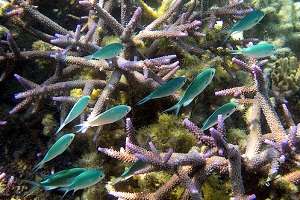Ningaloo coral comes out on top

Coral cover patterns along the WA coast have remained relatively stable over the last 25 years, according to recent meta-analytical research.
The study, led by Department of Parks and Wildlife expert Dr Conrad Speed analysed all available data on the coral reef ecology of 12,500km of WA coastline.
This data was sourced from 121 surveys included peer-reviewed literature, reports and unpublished data from monitoring programs, collected from federal and state governments, universities and industry between 1980 and 2012.
"To date, there hasn't been an attempt to compile all available information to assess the status of coral reef communities in WA, which could ultimately help direct future monitoring and research programs," Dr Speed says.
"We had a specific focus on assessing trends in cover and community composition for Ningaloo Reef, as this is where the most research on coral reefs in WA has been carried out."
For Dr Speed, the most interesting result from the analysis was the consistency of coral cover at Ningaloo Reef.
"Coral cover at Ningaloo has remained relatively stable at around 28 per cent over the past 25 years," he says.
"However, we did find significant declines in the north-east [Bundegi Reef, Exmouth] and south subregions [south of Pelican Point]."
These declines were most prominent in 1998-99, and attributed to destructive cyclone 'Vance', high sea surface temperatures and coral bleaching events.
In terms of coral communities, the Acroporidae coral family was found to have declined in relative abundance in the Ningaloo region over time, possibly due to its sensitivity to cyclones and raised temperatures.
As Acroporidae corals are an important habitat for juvenile fish and provide food to a large number of fish species, Dr Speed confirms that "further reductions could create a flow-on effect to adult fish stocks… diversity and abundance".
"Ningaloo Reef has demonstrated a level of resilience to natural impacts … which may in-part be related to its relative isolation compared to other more populated areas in the Indo-Pacific near coral reefs, which have seen serious declines in coral cover over the past couple of decades," Dr Speed says.
"This may be related to minimal run-off from urban or agricultural areas, and an absence of commercial fishing within the Ningaloo Marine Park."
"Further research would provide a robust baseline for assessing broader-scale impacts of climate change or trends in coral cover."
More information: www.plosone.org/article/info%3Adoi%2F10.1371%2Fjournal.pone.0069863
Provided by Science Network WA


















